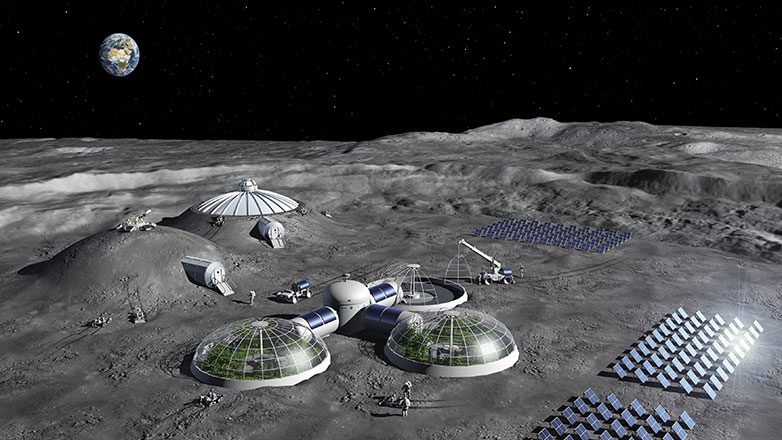
Editor-in-Chief: Stelios Vassillodis
Scientists have developed an energy source that could allow astronauts to live on the surface of the moon for extended periods of time.
The NASA-led Artemis program hopes to develop a base on the moon in the early 2030s. Bangor University in Wales has designed nuclear fuel cells – about the size of a poppy seed – to generate the energy needed to sustain life there. University professor Simon Middleberg says the job was a challenge – “but it was fun”.
The moon, considered by some to be the gateway to Mars, also contains many valuable resources needed for modern technology. The hope is that it can be used as a stepping stone to take humans to other planets or beyond. With space technology advancing at a rapid pace, the BBC has been granted exclusive access to the Laboratory of the Institute for the Nuclear Future, Bangor University, Wales. The Bangor Group, a world leader in fuels, works with NASA, the UK Space Agency, Los Alamos National Laboratory in the US and Rolls-Royce.
Speaking to the BBC, Prof Middleberg of the Nuclear Futures Institute said the team hoped to conduct a full test of nuclear fuel “in the coming months”. Bangor University is a major player in trying to find another way to generate energy and heat to sustain life there. The researchers recently sent the tiny nuclear fuel cell, known as a Trisofuel, to their collaborators for testing.
This cell can be used to power a small nuclear generator, created by Rolls-Royce. The generator is a portable device, about the size of a small car, and “something you can stick on a rocket”, says Professor Middelberg.
“It will now be fully tested and subjected to similar forces as a space launch, so that it will be ready for use on a lunar base in 2030. It will still function safely when it lands on the moon,” the professor added.
Earlier this month, India made a historic landing near the moon’s south pole using its robotic probe Chandrayaan-3. One of the main goals of the mission is to discover water ice that, scientists say, could support human colonization of the moon in the future.
As is well known, temperatures in some regions of the Moon drop to (astonishingly low) -243 degrees Celsius, due to the lack of an atmosphere to warm the surface.
Professor Middleberg said Bangor University’s work had put Wales on the map. “I would say we are moving things forward (globally),” he said. The university hopes that the small generators can be used here on Earth, as in disaster areas when electricity generation or supply is interrupted.
The Bangor team is also working on a nuclear system to power the rockets, led by Dr. Phyllis Makurong, who said: “The system is very powerful – it gives the rocket the boost it needs. This is very important because it allows the rockets to reach the most distant planets.”
Dr Makurongi believes the new technology could cut the time it takes a mission to get to Mars almost in half. “With nuclear thermal propulsion – the spacecraft will take about four to six months to reach Mars. The current duration is nine months or more,” he added.
Geopolitical writer and journalist Tim Marshall believes that the discovery of new fuels is just one step in a global race to the lunar south pole. He adds, “I’m sure there will be a base on the moon in the 2030s. Maybe Chinese, maybe American-led. I’m sure because I don’t think the big powers can afford not to be present when it comes to such a huge step. The Chinese are talking about a year 2028, with the symbolic placement of the first bricks that will allow them to say they were the first. But by the early 2030s, both competitors will have a base on the moon.”
Marshall continues: “Also, it is believed that there are titanium, lithium, silicon, iron and many other metals used in all sorts of 21st century technologies. The actual size of the mineral deposit is unknown, but most companies are convinced that it is enough to make them economically viable.
But he warns that things could get complicated as space becomes commoditized, citing outdated space laws. “The rules that apply now were written in 1967 – the Outer Space Treaty is still a model, but it’s 50 years out of date, because at that time they didn’t know about the new technology and their needs, the competition there as well as the commercial aspects – so almost all the missions were government. In conclusion he says:
“So, without updated laws, approved by the United Nations, there are risks. Because if there are no guidelines for the operation of the system, the obvious competition that will arise will be without a legal framework.”
Source: BBC News

“Avid problem solver. Extreme social media junkie. Beer buff. Coffee guru. Internet geek. Travel ninja.”





More Stories
Top 20 Most Played Games in June 2024
Play Age of Mythology: Retold Playtest starting today!
Impressive Maniskin Concert in Greece